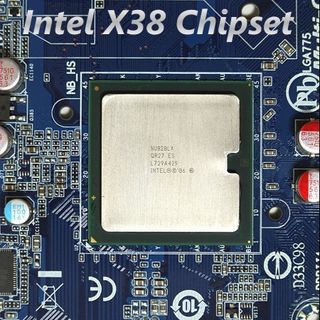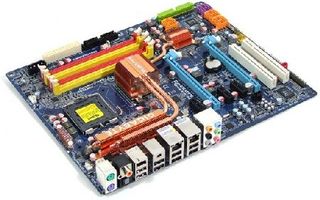Intel X38 Chipset: A Porsche with the Handbrake On
Ready For Penryn With 45 Nanometers

Unlike its unenthusiastically received 975X, which found its way onto only a handful of motherboards, the X38 shows all the signs of becoming a success. Motherboard companies are already pouncing on the chipset. As early as Computex 2007, every reputable company was showing off its designs. Compare Prices on X38 Motherboards

Let's begin, however, with a quick look at the recent history of Intel chipsets.
The 975X chipset, the X38's predecessor, was introduced upon the launch of Intel's 65 nm Pentium 4 processors in November 2005. These prohibitively expensive boards proved to be less than future-proof, however, as buyers were forced to purchase an updated revision if they wanted to use a Core 2 processor.
The mid-range i965P, on the other hand, had no such problems and ran just fine with the new Core 2 line. This greatly diminished the attractiveness of the high-end chipset. As a result, some companies, such as Gigabyte, decided not to produce 975X-based boards for Core 2 processors.
Five months ago, the P35 was unveiled, to give the Core 2 CPUs a platform with support for DDR3 memory. However, Intel positions this chipset in the mid-range, while the ill-received 975X remained the high-end solution. In the course of the P35's development, Intel also created the ICH9 South Bridge, which set a new performance standard among its peers.
On Monday, Intel unveiled the X38 chipset, which is to be the new high-end chipset for the Core 2 family, and brings several seminal technologies with it.
The only question that remains is why Intel needed this long to replace the 975X chipset with its aging ICH7 South Bridge, which is now outdated by two generations. One thing is certain, though: the 975X will not support the upcoming 45 nm Penryn processors and has thus passed on the title of "high-end chipset" to the next generation, the X38.
Stay on the Cutting Edge
Join the experts who read Tom's Hardware for the inside track on enthusiast PC tech news — and have for over 25 years. We'll send breaking news and in-depth reviews of CPUs, GPUs, AI, maker hardware and more straight to your inbox.
Tom's Hardware's dedicated news crew consists of both freelancers and staff with decades of experience reporting on the latest developments in CPUs, GPUs, super computing, Raspberry Pis and more.
Most Popular


